Ringness (APD-100)
1944–1974
Henry Raymond Ringness -- born in Morris, Minn., on 17 August 1912 -- to John A. and Ida V. Ringness. He had one sibling, a sister, Florence G. Ringness graduated from Morris High School in 1929, and received his pre-medical education at Macalester College at St. Paul, Minn., and at George Washington University at Washington, D.C. Graduating from George Washington University School of Medicine in 1939, he served an internship at Southern Pacific General Hospital at San Francisco, Calif. (1939–1940), and as the resident physician in Pathology at Doctor’s Hospital in the nation’s capital (1940–1941).
Ringness was appointed a 1st Lieutenant in the Medical Corps Reserve, U.S.A., on 14 June 1939. Two weeks later he resigned from the Army to accept a commission in the U.S.N. He was commissioned a regular assistant surgeon with the rank of Lt. (j.g.) from 7 July 1941. He completed brief post graduate instruction at the Naval Medical School at Washington, D.C. (8 August–23 September); instruction in aviation medicine at Naval Air Station, Pensacola, Fla. (27 September 1941–7 March 1942); and then reported to the First Marine Aircraft Wing, Fleet Marine Force, on 11 March. He was promoted to lieutenant on 15 June 1942, and just before he shipped out that month married Margaret V. Sutton, daughter of Rear Adm. Dallas G. Sutton, M.C., Medical Officer in Charge of the Naval Hospital at Portsmouth, Va.
On 7 August 1942, the Allies carried out Operation Watchtower—landings on Japanese-held Guadalcanal, Florida, Gavutu, Tanambogo, and Tulagi in the Solomon Islands. Ringness subsequently deployed as a Naval Flight Surgeon of Marine Aircraft Group 14 and joined the marines ashore at Henderson Field, an unfinished Japanese airstrip the marines had captured and redesignated in honor of Maj. Lofton R. Henderson, USMC, who had been shot down while leading Marine Scout Bombing Squadron (VMSB) 241 in an unsuccessful attack on the Japanese carrier Hiryū at the Battle of Midway.
On the night of 13–14 October 1942, Japanese Rear Adm. Kurita Takeo led a surface force comprising battleships Haruna and Kongō, light cruiser Isuzu, and seven destroyers that bombarded Henderson Field. The heavy shelling destroyed 48 of the 90 planes at the field, temporarily knocking the airfield out of action. The exploding shells trapped Ringness in the camp area as he sheltered in a foxhole, but fragments from a near miss mortally wounded the doctor in his left thigh, and fractured his simple 12th thoracic vertebra. The burst also killed four of his companions and wounded four others. Although completely paralyzed in the lower half of his body and suffering great pain because of his immobility, he persisted in administering morphine and blood plasma to wounded men until he was finally evacuated to a base hospital. Three days later, on 17 October 1942, he died as a result of his injuries, and was subsequently buried at Arlington (Va.) National Cemetery.
Ringness received the Navy Cross posthumously for his “extraordinary heroism” during the enemy bombardment. In addition, he received the Purple Heart Medal posthumously, the Presidential Unit Citation awarded to the First Marine Division for the division’s role in the liberation of Guadalcanal and the neighboring islands, the American Defense Service Medal, and the Asiatic-Pacific Area Campaign Medal.
(APD-100: displacement 2,130; length 306'0"; beam 37'0"; draft 12'7"; speed 23 knots; complement 204; troop 162; armament 1 5-inch, 6 40 millimeter, 6 20 millimeter, 2 depth charge tracks; class Crosley)
Ringness (DE-590) was laid down on 23 December 1943 at Hingham, Mass., by Bethlehem-Hingham Shipyard, Inc.; launched on 5 February 1944; sponsored by Mrs. Virginia S. Ringness, widow of the late Lt. Ringness; reclassified to a high-speed transport (APD-100) on 17 July 1944; and commissioned on 25 October 1944, Lt. Cmdr. William C. Meyer in command.
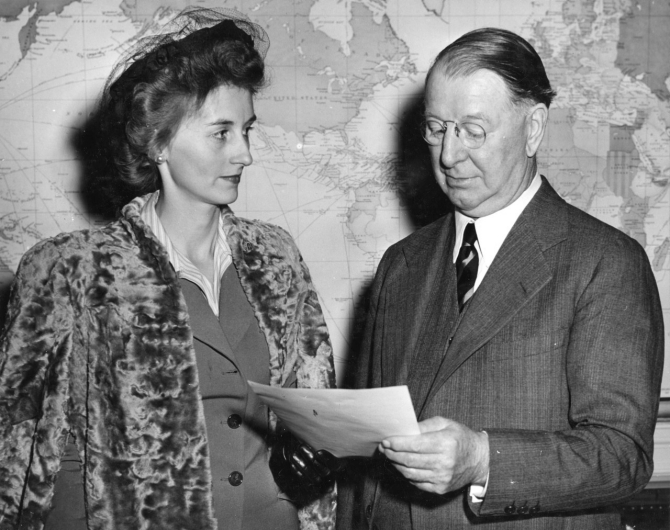
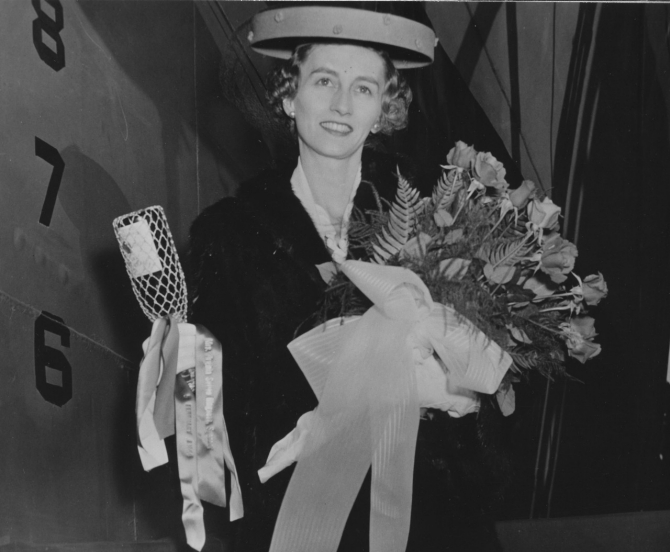
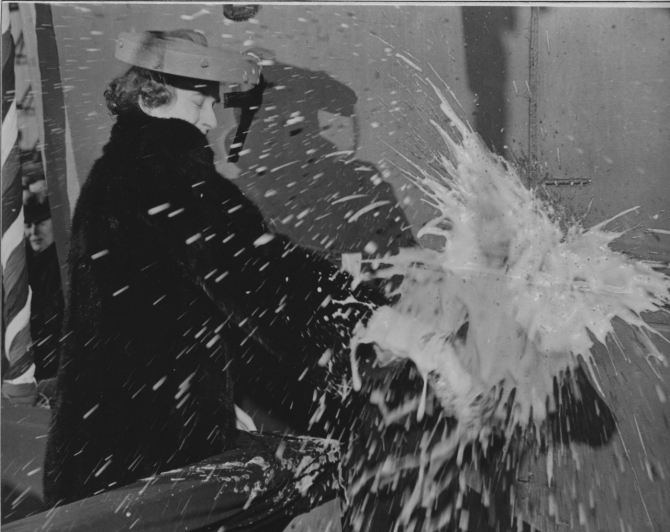
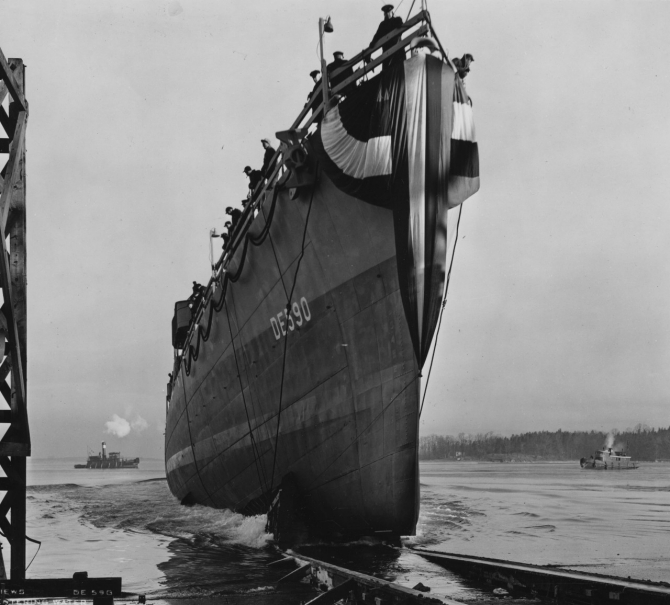
Following additional sea trials in Massachusetts Bay and equipment installations (26 October–14 November 1944), the ship sailed on her shakedown cruise in company with the light minelayer Tolman (DM-28). Arriving at Bermuda on 17 November, Ringness spent three weeks training primarily in gunnery, antisubmarine operations, and ship handling. On 4 December, Ringness weighed anchor and made for Norfolk, Va., but heavy seas lashed the ship during her passage, increasing in fury until she recorded a 52° roll off Cape Hatteras, N.C. The ship’s historian noted that many crewmen waggishly referred to the experience as a “shakedown” cruise. The battered transport reached Norfolk on 6 December, but the next day returned to sea and participated in amphibious exercises in the Cove Point area of Chesapeake Bay, and then completed her post-shakedown availability and trial runs.
Ringness began her long voyage to the Pacific to fight the Japanese when she steamed from Norfolk in company with Crosley (APD-87) and Bulmer (AG-86), escorting attack transport Henrico (APA-45), and transports Florence Nightingale (AP-70) and Thurston (AP-77), on 21 December 1944. She reached Colón at the Panama Canal, passed through the canal in company with Crosley, and on 27 December 1944, entered the Pacific Ocean as officer in tactical command (OTC) and the two ships proceeded to San Diego, Calif. Ringness then stood down that channel in company with Bunch (APD-79) -- the OTC -- and Hopping (APD-51), and the three ships steamed to Pearl Harbor, T.H. (9–15 January 1945).
The ship trained with underwater demolition teams in the Hawaiian area, the secret nature of her operations requiring tightened censorship. Ringness received orders directing her to additional duties, however, and she passed Diamond Head and steered southerly courses on 1 March 1945. On 7 March, Ringness hoisted the “Jolly Roger” as she crossed the equator. King Neptune and his royal party boarded the ship and initiated 179 crewmen into the mysteries of the deep. The transport’s historian observed that the Pollywogs endured their collective humiliation without “casualties,” but added that many of them “found standing up more comfortable than sitting down” during the days following the crossing, and that the ship’s barber found his prospects of business “decidedly poor.” Ringness refueled in the lagoon at Funafuti in the Ellice Islands (Tuvalu) that day, and the following day resumed her voyage. She anchored briefly at Port Purvis, Florida Island, in the Solomons on 13 March, but her historian commented that the stop proved less than memorable because of the “torrid climate.” Ringness turned northward and in company with Drexler (DD-741) and Massey (DD-778) shepherded escort aircraft carriers Chenango (CVE-28) and Suwanee (CVE-27) to Ulithi in the Caroline Islands, reaching that atoll on 22 March. Crewmen noted that they had never seen so many ships gathered in a single anchorage as the Allies prepared for Operation Iceberg—the invasion of Okinawa in the Ryūkyū Islands.
After further training, Ringness proceeded at 20 knots on the morning of 24 March 1945 to Saipan in the Marianas, reaching that island two days later. On 27 March she stood out from Saipan as part of the screen for Task Group (TG) 51.2, composed of transports and cargo vessels earmarked to take part in Iceberg. The initial landings took place on Easter morning, 1 April 1945, and during the two days following, Ringness patrolled against Japanese suicide boats along the southeast coast of Okinawa, where intelligence reports had located nests of the vessels. On the night of 2 April, Ringness attacked what she believed to be an enemy midget submarine but with undetermined results. On 3 April she steamed in company with Humphreys (APD-12) and Sims (APD-50) to Ulithi for supplies, reaching her destination three days later, and returning to Okinawa with TG 53.8, a convoy of transports and cargo vessels. Upon arrival, she carried out antisubmarine and antiaircraft patrols.
On 6 April 1945, the Japanese launched the first of a series of ten mass kamikaze attacks, interspersed with smaller raids and named Kikusui (Floating Chrysanthemum) No. 1, against Allied ships operating off Okinawa. These attacks involved 1,465 aircraft through 28 May. Ringness consequently endured numerous air attacks, including a kamikaze that passed over her bow and crashed close aboard light cruiser St. Louis (CL-49). That patrol lasted only four days before she steamed as a convoy escort with TU 51.29.16 to Saipan (16–21 April).
At 0512 on 23 April 1945, she again steamed for Okinawa as part of Task Unit (TU) 94.19.14, also comprising Barr (APD-39), Fieberling (DE-640), and Riddle (DE-185), escorting convoy SON-2, consisting of 13 tank landing ships (LSTs) and six medium landing ships (LSMs). Lt. Cmdr. Edward E. Lull, USNR, Fieberling’s commanding officer, guided the convoy, and Commander LST Group 62 was the OTC. The following morning Riddle, which had been damaged during a Japanese kamikaze suicide plane attack on 12 April and only completed partial repairs, detached from the convoy and returned to Saipan for additional work.
During the forenoon watch four days later, I-36 (Lt. Cmdr. Sugamasa Tetsuaki commanding), launched four kaiten suicide torpedoes, piloted by Lt. (j.g.) Yagi Teiji, and PO2 Abe Hideo, Ebihara Kiyosaburo, and Matsuda Mitsuo. Two of the kaitens malfunctioned and failed to launch, but the other two worked with their mother boat and stalked Allied ships in the area. The weather was overcast, visibility seven miles, and the sea calm. The U.S. convoy steered a course of 297°, speed nine knots, Fieberling operating as the guide 3,000 yards on Ringness’ port bow when the ships reached a position near 24°3'N, 132°39'E. Ringness patrolled the path of the convoy from Station 3, steering 270° at 11 knots. Suddenly, at 0823 on 27 April 1945, CBM W. C. Upham, on the bridge talking to Lt. R. C. Wells Jr., the officer of the deck, sighted what he believed to be a whale, bearing about 050°T, range 800 to 1,500 yards. Almost simultaneously, S1 A. J. Conway, a member of the gun crew on No. 43 gun, sighted the disturbance in the water, but both men and multiple watchstanders realized with horror that a torpedo raced inbound. The weapon knifed through the water erratically and passed just astern of the ship within 75 yards.
The ship sounded battle stations at 0825 and notified the convoy of the attack, Lt. Cmdr. Meyer took the Conn, and lookouts sighted a periscope bearing 110° at 300 yards. I-36’s periscope and fin abruptly broke the water, making a large feather. Meyer ordered “Hard left rudder!” and Ringness swung to 180°—an apparent collision course with the submarine. Many of the .50 caliber, 20 millimeter, and 40 millimeter guns opened fire on I-36, and some of the rounds struck around the periscope and tail fin, but the gunners believed that few of the hits damaged the enemy boat. At 0826 a second torpedo hurtled past the ship ahead, running true but missing by a scant 25 yards. Sugamasa meanwhile took his boat down, and Meyer ordered “Hard right rudder!” over to 200° because Ringness appeared to be going astern of the submarine’s estimated position. The ship fired four depth charges, estimating the time of firing with regard to I-36’s position when she dived and to the wake of the second torpedo. The convoy had continued on its course, however, and Ringness veered right to avoid colliding with LSM-360, which led Column 5. Fieberling also gained a sonar contact at one point, about 2,000 to 3,000 yards from where Ringness depth charged her suspected enemy, but did not confirm a submarine.
The ship slowed to all ahead one-third (five knots) at 0829, and commenced searching the area of I-36’s estimated track. A lookout spotted a slick bearing 070° from where the ship fired her initial depth charge pattern, and the high-speed transport increased to ten and then 15 knots. A huge explosion erupted at 0845, bearing 080° and 1,000 to 2,000 yards from the original attack, throwing a column of water into the air 150 to 200 feet, and leaving a large amount of debris on the surface. The ship lowered a boat and sailors observed a mix of wood and cork floating in the water and recovered several pieces of wood. Fears of another submarine lurking in the area persuaded the OTC to order Ringness to return to protect the convoy at 0901, and she recovered the boat. Meyer gamely requested permission to rejoin the convoy slowly at 15 knots in order to continue searching for submarines, but the OTC initially granted him permission and then rescinded the order, so Ringness came about at flank speed. The ship fired 75 rounds of .50 caliber, 60 20 millimeter, and 18 40 millimeter rounds during the brief battle. Meyer reported that he considered it “a vital and urgent military necessity” to equip escorts with side depth charges throwers and more than 16 depth charges. Lull evaluated the ship’s performance, noting that she attacked “rapidly and effectively,” and that her alertness “may well have prevented destruction of one or more ships of the convoy.”
The ship’s sonar detected another apparent submarine at 1034, bearing 275°T, range 350 yards. She made an “urgent” attack, dropping four depth charges set at 100', 150', 100', and 150', apparently without result. Ringness continued her search until 1109 and then rejoined the convoy. Her sonar recorded a possible submarine the next day as well, but that contact also proved illusory. On 30 April 1945, Ringness arrived off Okinawa for the third time since the invasion began, maintaining her various antisubmarine and antiaircraft screen stations through most of the month of May. Japanese planes ferociously attacked the ships operating offshore, and Ringness reported that only “constant alertness” ensured her survival, and that general quarters replaced war cruising watches as a condition of readiness.
On 4 May 1945, Sangamon (CVE-26) put into Kerama Rettō to rearm. Enemy planes in the area frequently interrupted the ship’s loading, which she did not complete until evening. At 1830, the carrier stood out of the anchorage, but Japanese attackers appeared only some 29 miles off. Land-based fighters vectored out to intercept the enemy shot down nine planes, but one got through and, at about 1900, began circling toward a position on Sangamon's port quarter. The ship went into a hard left turn to avoid the enemy and to maneuver into a launching position. She then opened fire, joined by her escorts, and the gunfire splashed the enemy into the water some 25 feet off the carrier’s starboard beam.
Other bogies followed the first, and at 1925 a plane broke through the interceptors; ran into clouds to avoid antiaircraft fire; then came out and, with increased speed, headed for Sangamon. At 1933, the kamikaze dropped a bomb and crashed into the center of the flight deck. The bomb, and parts of the plane, penetrated that deck and exploded below, hurling flames and fragments in all directions, turning her into a roaring inferno. Fires broke out on the flight deck, the hangar deck, and in the fuel deck; communications from the bridge were lost within 15 minutes; and the ship soon swung out of control, the wind causing the flames and smoke to change direction, spreading the fires. By 2015, however, after steering established steering control and brought the ship back to a course which helped crewmen fight the myriad fires. The attack ruptured the fire-main and risers, reducing the water pressure; some firefighters brought CO2 bottles into action. Nearby ships rendered assistance, and Ringness stood by the crippled vessel and rescued some of the men forced over the side by flames and explosions, and provided medical treatment to some of the casualties. By 2230, the carrier’s crew controlled all the fires, and at 2320, Sangamon, with 11 dead, 25 missing, and 21 seriously wounded, got underway to return to Kerama Rettō for temporary repairs.
The Japanese continued their attacks relentlessly and Allied sailors began to refer to Radar Picket Station 15 northwest of Okinawa as the “hot corner,” because of the intensity of the fighting in that sector. Evans (DD-552), Hugh W. Hadley (DD-774), support landing craft LCS-82 and LCS-84, and two smaller craft patrolled that station when more than 100 Japanese planes attacked them in waves on the morning of 11 May 1945. The ships fought determinedly against this overwhelming assault, the destroyers maneuvering at high speed and firing furiously at their attackers, but the Japanese damaged both ships. Four kamikazes struck Evans in rapid succession, flooding her engineering spaces, and the destroyer lost power at about 0900. With the same courage that Evans’ crew had shown in fighting their ship, they saved her, using portable fire extinguishers, bucket brigades, and handy billies, supplemented by salvage gear provided by LCS-84, which moved alongside to render assistance. LCS-82 meanwhile rescued men blown overboard into the sea. Evans lost 32 men killed and 27 wounded, and subsequently received the Presidential Unit Citation for high gallantry and achievement.
At 0920 as many as ten planes simultaneously attacked Hugh W. Hadley, from both ahead and astern. The ship splashed her attackers, but not without damage to herself. One bomb hit aft, a MXY7 Ohka (cherry blossom) Model 11 flying bomb slammed into her, and two kamikazes crashed the ship as the gunners ran low on ammunition. Finally, as the attack ended, all but 50 crewmen were ordered over the side in life rafts, the remaining men fighting the fires and working to control the damage. Though water poured into her engineering spaces and she was badly holed, the determination and skill of the damage control parties kept Hugh W. Hadley afloat. Ringness received sudden orders to make for that station for the rescue and salvage work, and she came about and increased speed to 25 knots -- she was designed to reach 23 -- and raced to the area. The smoke of battle had scarcely cleared when Ringness reached the station and began rendering assistance to the stricken ships. Evans transferred her 27 wounded men to LCS-84, which shifted them to Ringness. In addition, the latter took on board 120 of the destroyer’s crewmen not required for the salvage work. Evans was later taken in tow into Kerama Rettō for her initial repairs, and Hugh W. Hadley eventually completed hers at Ie Shima (lejhima).
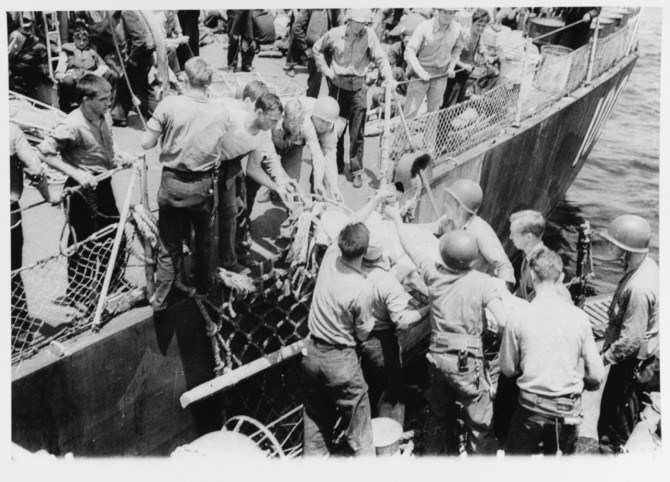
The enemy air assault continued during the following days, and on the night of 16 May 1945, Ringness fought what her historian reported as a “strange and tense duel” with a kamikaze just off Okinawa. The ship’s Combat Information Center (CIC) reported the bogey on the radar at 2318, and the Japanese pilot evidently followed the ship’s wake and turned into his suicide dive. The darkness impeded the ship’s gunners and the captain ordered her to flank speed and maneuvered wildly to avoid the attacker. The kamikaze apparently overshot his mark and circled around for a second attack, and at 2324 again dove on the ship, but missed and crashed in flames, exploding in her churning wake.
On the last night of May, Ringness received orders to come about, and the following morning found her anchored at Hagushi Beach, Okinawa, making preparations for her voyage from the fighting. Early that morning Japanese planes attacked the area just as Ringness hauled down her Union Jack and began moving out of the anchorage. A kamikaze roared past the ship and crashed into the anchorage she had just vacated, providing a dramatic climax to her time in the battle. The ship rendezvoused with Hutchins (DD-476), William C. Cole (DE-641), and minesweeper Buoyant (AM-153), and the four ships escorted a convoy of merchantmen to Ulithi, arriving on 6 June. The following day Ringness proceeded in company with Charles E. Shields (DD-596), George E. Davis (DE-357), and William C. Cole to Leyte in the Philippine Islands. Upon arrival there she completed an availability alongside destroyer tender Sierra (AD-18) and in non-self-propelled auxiliary repair dock ARD-16 (12–28 June).
Ringness served as the escort commander when, in company with John C. Butler (DE-339), Register (APD-92), and submarine chaser SC-1315, she escorted a convoy of LSTs from Leyte, reaching Okinawa auspiciously on Independence Day (29 June–4 July). The next day the high-speed transport patrolled for submarines and watched for kamikazes, and then again served as the escort commander when she sailed with John C. Butler, Burke (APD-65), and Register shepherding a convoy of merchantmen to Ulithi. On the day after their arrival at that atoll, Ringness served as the OTC when she returned with Burke and Register to Leyte. Ringness then shifted to an escort group and trained with heavier men-of-war off Leyte and Samar, including escorting battleship New Mexico (BB-40) for two days of the exercise (24–26 July). On 29 July Ringness and Register escorted Chenango (CVE-28) and Gilbert Islands (CVE-107) from Leyte to Ulithi. While returning on 2 August, an Eastern TBM asked the ship to assist in the search for an enemy submarine the Avenger’s crewmen believed they had sighted in an area about 200 miles east of Samar. Two escorts already in the area relieved Ringness, however, and she came about from the search.
Japanese submarine I-58 torpedoed and sank heavy cruiser Indianapolis (CA-35) northeast of Leyte, near 12°02'N, 134°48'E, on 29 July 1945. Crewmen who abandoned ship suffered horrifically from exposure and shark attacks. On 2 August, a Lockheed PV-1 Ventura from Fleet Air Wing (FAW) 18, commanded by Lt. (j.g.) S. M. Worthington, USNR, and flown by a relief crew from Patrol Bombing Squadron (VPB) 28, en route from Saipan in the Marianas to Jinamoc in the Philippine Islands, sighted some of the ship’s survivors in what appeared to be a lifeboat, as well as rafts and life jackets, around 11°32'N, 133°34'E. The Ventura reported the sighting, and the Philippine Sea Frontier Command relayed the discovery to a number of ships operating in the region.
On 3 August 1945, Ringness received urgent orders diverting her from escort duty and she steamed to the area of the cruiser’s loss. Planes flew overhead and fired flares and turned on their searchlights to illuminate the survivors for the rescue ships, which also initially included destroyers Ralph Talbot (DD-390) and Madison (DD-425), Bassett (APD-73), Register, and Ringness, and escorts Cecil J. Doyle (DE-368) and Dufilho (DE-423). Two Consolidated PBY Catalinas had landed in the water before dusk and also illuminated the scene. At 1400 Ringness joined four other ships in a scouting line from left to right: Madison; Ringness, Register; Ralph Talbot; and Dufilho. The ships initially steered 135° at 15 knots. At 0350 on 5 August, eight ships formed a scouting line in order: Helm (DD-388); Alywin (DD-355); Ralph Talbot; Madison; Dufilho; Alvin C. Cockrell (DE-366); French (DE-367); and Cecil J. Doyle. The Officer in Tactical Command (OTC) rode in Madison, and the ships proceeded in column on an initial course of 108°, spaced approximately eight miles apart, at a speed of 14 knots. Register and Ringness joined the column at about 1000, and Alvin C. Cockrell relieved Madison as the OTC and guide at 1405. The ten ships continued their search at various courses and speeds until they covered the area determined to be the most likely to contain survivors, by 1907. Ringness maintained her “constant vigil” until the ship’s fuel fell dangerously low, and she then came about to refuel at Palau, having rescued the cruiser’s commanding officer, Capt. Charles B. McVay III, and 38 enlisted survivors. Ringness transferred her charges ashore, refueled, and returned to the calculated possible area of the men in the water and searched unsuccessfully for additional survivors.
Ringness lay at Leyte Gulf on 10 August 1945 when she received news of the Japanese willingness to accept the Potsdam Declaration and surrender (but to retain the Emperor). Ships jubilantly sounded their horns and whistles and fired multi-colored flares in celebration of Allied victory—and their survival. The ship lay anchored quietly off Guian, Samar, when she received new of the enemy’s surrender, four days later. On 20 August, Ringness sailed in company with Arkansas (BB-33), California (BB-44), Nevada (BB-36), Texas (BB-35), Biloxi (CL-80), Mobile (CL-63), Gainard (DD-706), Abercrombie (DE-343), Charles Lawrence (APD-37), Hopping, John Q. Roberts (APD-94), Lee Fox (APD-45), Register, and Tollberg (APD-103) to Okinawa. Upon arrival, orders directed her to take part in Operation Blacklist 40—the Allied occupation of the southern half of the Korean peninsula. Ringness lay out with the screen of TU 78.1.15 escorting transports and cargo ships carrying soldiers and equipment of the Army’s XXIV Corps on 5 September. Lookouts scanned the water for floating mines as the ships proceeded on northerly courses and Ringness acted as the flagship for the forces beachmaster the Seventh Amphibious Force representative when the troops landed at Jinsen, Chōsen (Incheon, Korea), on 9 and 10 September. The ship also quartered the Port Director and his staff, and served as their communication guard. Following the landings, Ringness detached and departed Jinsen, and with Balduck (APD-132) escorted Pondera (APA-191) to Hagushi (26–28 September).
Three days later, Ringness commenced her second occupation operation when she stood out of Nago Wan, Okinawa, as the sole escort for TU 78.1.94, comprising Monrovia (APA-31) -- the flagship -- Montauk (LSV-6), Lacerta (AKA-29), Mellena (AKA-32), Montague (AKA-98), Fuller (APA-7), and Warren (APA-53), bound for Tientsin (Tianjin), China. At 0723 on 2 October, a Ringness lookout spotted a four-horned Japanese floating mine directly in the convoy’s path, but the ship detonated the device with 40 millimeter gunfire and the convoy continued safely. She lay at anchor off Tientsin for four days and then embarked the Seventh Amphibious Force Beachmaster and his staff and steamed to Tsingtao [Qingdao]. The ship arrived on 9 October while tensions flared between Japanese troops and Chinese communists, but two days later U.S. marines landed and prevented the rivals from renewing the fighting. The beachmaster and his men departed Ringness on 12 October, and the ship then served as the Port Director’s flagship and the amphibious force’s representative. Commander LST Flotilla 22 shifted his flag to Ringness on 15 December 1945, and she assumed additional duties as the communication guard for TG 78.15, which directed the repatriation of Japanese troops and civilians from the Tsingtao area. Ringness continued in that capacity at Tsingtao until 22 January 1946, when she was relieved of all duties and completed engineering repairs, before departing for the United States at 1000 on 29 January.
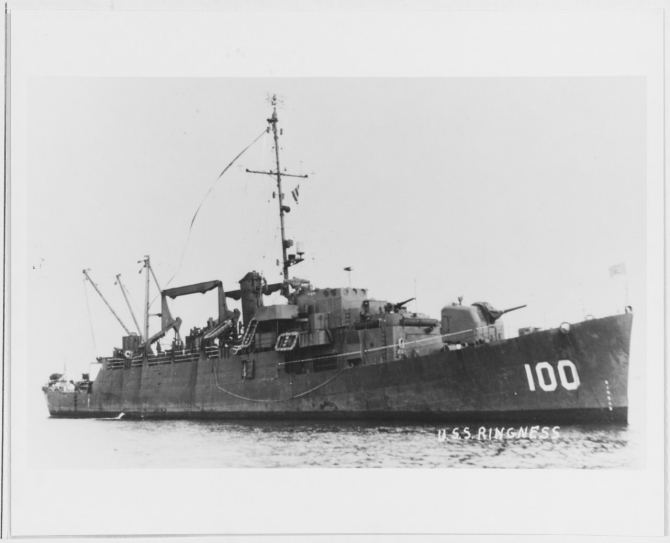
She arrived at San Pedro, Calif., on 23 February, passed through the Panama Canal, and put into Norfolk on 14 March. Ringness reported for lay-up at Green Cove Springs, Fla., on 4 April 1946. She was subsequently taken under tow from Green Cove Springs to Mayport, Fla., and Charleston, S.C., at various times in 1947 and 1948. Ringness was placed out of commission in reserve in January 1951, and berthed at Green Cove Springs.
In 1959 she was towed to Norfolk, where she remained until moved to the Inactive Ship Storage Facility at Orange, Texas in 1966. Ringness was reclassified to a small amphibious transport (LPR-100) on 1 January 1969, and stricken from the Naval Vessel Register on 15 September 1974.
On 11 August 1975, commercial tugs Taurus of Wade Towing Co., of Brownsville, Texas, Hermes and Vulcan of Sabine Towing and Transportation Co., of Port Arthur, Texas, and Grampus of G&H Towing of Houston took ex-Diachenko (LPR-123), ex-Horace A. Bass (LPR-124), ex-Kirwin (LPR-90), and ex-Ringness in tow from Orange for scrapping at various yards.
Commanding Officer Date Assumed Command
Lt. Cmdr. William C. Meyer 25 October 1944
Ringness earned one battle star for her World War II service.
Mark L. Evans
14 June 2016


